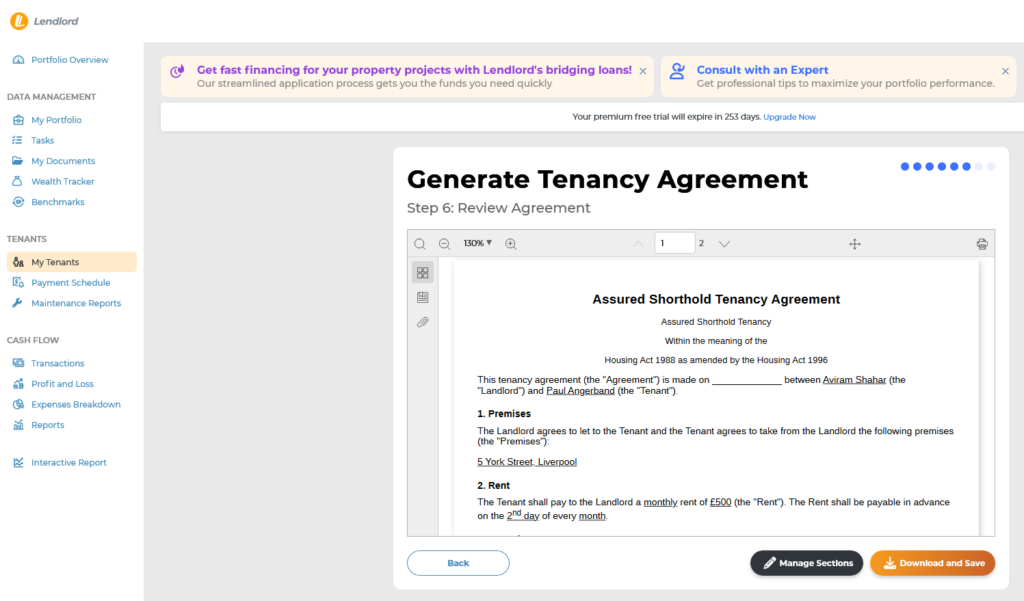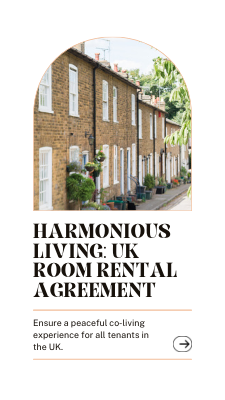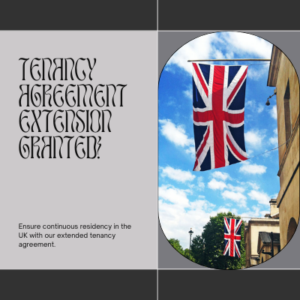Key Inclusions in a Room Rental Agreement Template
Rent Amount and Payment Terms
An Assured Shorthold Tenancy (AST) Agreement is a contract that outlines the terms of a residential tenancy, detailing the rights and responsibilities of both the landlord and the tenant.
Typically, an AST is a written agreement, although it can also be verbal, and it specifies key terms such as the start and end dates of the tenancy, the rent amount, and the obligations of both parties.
For instance, it outlines the tenant’s duty to maintain the property’s condition and the landlord’s responsibilities during the tenancy.
ASTs can be customized to suit various rental situations, whether for a fixed-term or a periodic tenancy, and are used for renting different types of properties like houses, flats, or rooms. In different regions, this agreement may be known as a short-term tenancy agreement, landlord tenancy agreement, or rental agreement.
Using an AST provides clarity, prevents disputes, and legally protects both landlords and tenants by ensuring that all parties understand and agree to the tenancy terms.
This agreement becomes legally binding once all parties have signed it. For changes or updates, a Lease Addendum can be used to amend the agreement without creating a new one.
Security Deposit Requirements
An Assured Shorthold Tenancy (AST) Agreement is a contract that outlines the terms of a residential tenancy, detailing the rights and responsibilities of both the landlord and the tenant.
Typically, an AST is a written agreement, although it can also be verbal, and it specifies key terms such as the start and end dates of the tenancy, the rent amount, and the obligations of both parties.
For instance, it outlines the tenant’s duty to maintain the property’s condition and the landlord’s responsibilities during the tenancy.
ASTs can be customized to suit various rental situations, whether for a fixed-term or a periodic tenancy, and are used for renting different types of properties like houses, flats, or rooms. In different regions, this agreement may be known as a short-term tenancy agreement, landlord tenancy agreement, or rental agreement.
Using an AST provides clarity, prevents disputes, and legally protects both landlords and tenants by ensuring that all parties understand and agree to the tenancy terms.
This agreement becomes legally binding once all parties have signed it. For changes or updates, a Lease Addendum can be used to amend the agreement without creating a new one.
Landlord Responsibilities and Tenant Duties
An Assured Shorthold Tenancy (AST) Agreement is a contract that outlines the terms of a residential tenancy, detailing the rights and responsibilities of both the landlord and the tenant.
Typically, an AST is a written agreement, although it can also be verbal, and it specifies key terms such as the start and end dates of the tenancy, the rent amount, and the obligations of both parties.
For instance, it outlines the tenant’s duty to maintain the property’s condition and the landlord’s responsibilities during the tenancy.
ASTs can be customized to suit various rental situations, whether for a fixed-term or a periodic tenancy, and are used for renting different types of properties like houses, flats, or rooms. In different regions, this agreement may be known as a short-term tenancy agreement, landlord tenancy agreement, or rental agreement.
Using an AST provides clarity, prevents disputes, and legally protects both landlords and tenants by ensuring that all parties understand and agree to the tenancy terms.
This agreement becomes legally binding once all parties have signed it. For changes or updates, a Lease Addendum can be used to amend the agreement without creating a new one.
Rent Increase Provisions and Agreement Termination
An Assured Shorthold Tenancy (AST) Agreement is a contract that outlines the terms of a residential tenancy, detailing the rights and responsibilities of both the landlord and the tenant.
Typically, an AST is a written agreement, although it can also be verbal, and it specifies key terms such as the start and end dates of the tenancy, the rent amount, and the obligations of both parties.
For instance, it outlines the tenant’s duty to maintain the property’s condition and the landlord’s responsibilities during the tenancy.
ASTs can be customized to suit various rental situations, whether for a fixed-term or a periodic tenancy, and are used for renting different types of properties like houses, flats, or rooms. In different regions, this agreement may be known as a short-term tenancy agreement, landlord tenancy agreement, or rental agreement.
Using an AST provides clarity, prevents disputes, and legally protects both landlords and tenants by ensuring that all parties understand and agree to the tenancy terms.
This agreement becomes legally binding once all parties have signed it. For changes or updates, a Lease Addendum can be used to amend the agreement without creating a new one.
Understanding the Rent a Room Scheme and Lodger Agreements
Benefits of the Rent a Room Scheme
The process of creating your own customized tenancy agreement has never been easier. You can easily generate a tenancy agreement with Lendlord’s free tenants management tool.
Go to Manage->My Tenants and start customizing your tenancy agreement by editing the template. Once you have finished editing, click on the “Download and Save” button to get the tenancy agreement as a PDF file.

Differences Between Lodger and Tenant Agreements
The process of creating your own customized tenancy agreement has never been easier. You can easily generate a tenancy agreement with Lendlord’s free tenants management tool.
Go to Manage->My Tenants and start customizing your tenancy agreement by editing the template. Once you have finished editing, click on the “Download and Save” button to get the tenancy agreement as a PDF file.
Tax Implications for Resident Landlords
The process of creating your own customized tenancy agreement has never been easier. You can easily generate a tenancy agreement with Lendlord’s free tenants management tool.
Go to Manage->My Tenants and start customizing your tenancy agreement by editing the template. Once you have finished editing, click on the “Download and Save” button to get the tenancy agreement as a PDF file.
Situations Requiring a Lodger Agreement
The process of creating your own customized tenancy agreement has never been easier. You can easily generate a tenancy agreement with Lendlord’s free tenants management tool.
Go to Manage->My Tenants and start customizing your tenancy agreement by editing the template. Once you have finished editing, click on the “Download and Save” button to get the tenancy agreement as a PDF file.
Legal Considerations: Rent, Deposits, and Tenant Responsibilities
Setting and Adjusting Market Rent
Rent-to-rent agreements in the UK involve an intermediary, often a company or individual, leasing a property from the owner and then subletting it to tenants.

This arrangement can be beneficial for property owners who prefer a guaranteed rent without the hassle of managing tenants directly.
The intermediary, or rent-to-rent operator, takes on the responsibilities of maintaining the property, finding tenants, and handling day-to-day management, while the property owner receives a fixed monthly income.
However, rent-to-rent agreements require careful consideration of legal aspects, including ensuring the operator has permission to sublet and that the agreements with subtenants comply with local housing regulations.
It’s crucial for both property owners and intermediaries to conduct thorough due diligence and establish clear terms to avoid potential disputes and ensure a successful arrangement.
Deposit Protection and Compliance
Extending a tenancy agreement for ongoing residency in the UK is a common practice that provides stability for both tenants and landlords.
When the initial fixed-term tenancy period is nearing its end, both parties can agree to extend the agreement, ensuring the tenant can continue to reside in the property without interruption.

This extension can be formalized through a written addendum to the original contract or by signing a new tenancy agreement. Extending the tenancy often involves reviewing and potentially updating terms such as rent, maintenance responsibilities, and any changes in legal requirements.
For tenants, it offers the security of continued housing, while landlords benefit from retaining reliable tenants and avoiding the costs and uncertainties associated with finding new occupants.
Clear communication and mutual agreement are key to a smooth extension process, fostering a positive landlord-tenant relationship.
Tenant Duties Under the Homes (Fitness for Human Habitation) Act
A tenancy agreement break clause is an essential feature that offers flexibility for both tenants and landlords in the UK rental market.
This clause allows either party to terminate the tenancy before the fixed term ends, given proper notice is provided, typically outlined in the contract.

For tenants, a break clause provides an exit strategy if circumstances change, such as job relocation or personal reasons, without being tied to the full term of the lease.
For landlords, it offers the ability to regain possession of the property if needed, for example, if they decide to sell or move back into the property.
The specific terms of a break clause, including the notice period and any conditions that must be met, vary and should be clearly defined in the tenancy agreement to avoid disputes.
Understanding and negotiating the break clause can lead to a more adaptable and harmonious rental experience, accommodating the evolving needs of both parties.
Procedures for Ending a Room Rental Agreement
Crafting the perfect tenancy agreement renewal in the UK is essential for maintaining a stable and positive living arrangement for both tenants and landlords.
As the initial tenancy term approaches its end, a well-structured renewal process ensures continued satisfaction and compliance with legal requirements.
The renewal agreement should revisit and possibly revise key terms such as rent adjustments, maintenance responsibilities, and any updated legal obligations. This is also an opportunity to address any issues that arose during the previous term and to make mutually beneficial changes.
Clear communication between the tenant and landlord is vital to ensure both parties’ needs and expectations are met.
By carefully considering and negotiating the terms of the renewal, tenants can enjoy uninterrupted residency while landlords retain reliable occupants, fostering a sense of security and stability for all involved.
Q&A
- Landlord: The owner of the property.
- Intermediary: The company or individual renting from the landlord and subletting to tenants.
- Tenants: The end occupants of the property, who pay rent to the intermediary.
- Guaranteed Rent Agreement: The intermediary guarantees a fixed rental income to the landlord regardless of whether the property is occupied or not.
- Management Agreement: The intermediary manages the property on behalf of the landlord and takes a percentage of the rental income as a fee.
- Intermediary: Responsible for finding tenants, collecting rent, and managing the property, including maintenance and repairs.
- Landlord: May have limited involvement but retains ownership and ultimate responsibility for ensuring the property complies with legal standards.
- Tenants: Rent the property as if directly from the landlord but often sign agreements with the intermediary.
- Licensing: Properties may require specific licenses, such as House in Multiple Occupation (HMO) licenses if subletting to multiple tenants.
- Contracts: Clear contracts outlining responsibilities and terms are crucial to avoid disputes.
- Compliance: The property must comply with housing standards, health and safety regulations, and landlord obligations under the law.
- Landlords: Receive consistent rental income without managing the property.
- Intermediaries: Can profit from the difference between the rent paid to the landlord and the rent collected from tenants.
- Tenants: Often get well-maintained properties with responsive management.
- Landlords: Potential issues with property management and compliance if the intermediary fails to uphold standards.
- Intermediaries: Financial risk if they cannot sublet the property or cover the guaranteed rent.
- Tenants: Possible instability if the intermediary’s business fails or if there are disputes between the intermediary and the landlord.
- Due Diligence: Landlords should thoroughly vet intermediaries and ensure they have a good track record.
- Clear Agreements: Detailed contracts should clearly define roles, responsibilities, and expectations.
- Regular Checks: Landlords should periodically inspect the property to ensure it is being maintained and managed properly.


